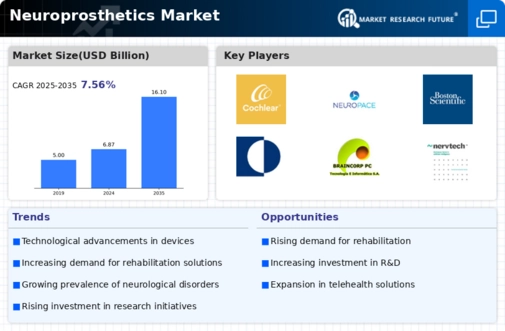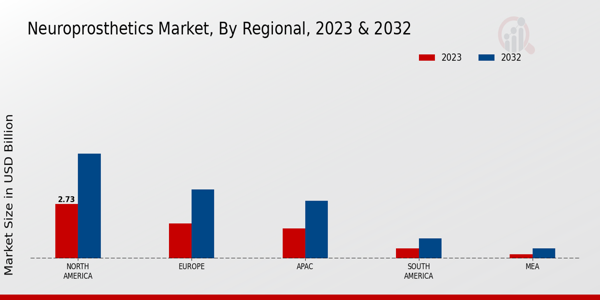Market Growth Projections
The Global Neuroprosthetics Market Industry is poised for substantial growth, with projections indicating a market size of 16.1 USD Billion by 2035. This anticipated expansion reflects the increasing demand for advanced neuroprosthetic solutions driven by technological advancements, rising prevalence of neurological disorders, and supportive government initiatives. The market is expected to experience a robust CAGR of 8.02% from 2025 to 2035, highlighting the potential for innovation and investment in this sector. The convergence of these factors suggests a promising future for neuroprosthetics, as stakeholders seek to enhance the quality of life for individuals with neurological impairments.
Government Initiatives and Funding
Government initiatives aimed at promoting research and development in neuroprosthetics significantly influence the Global Neuroprosthetics Market Industry. Various countries are investing in healthcare infrastructure and funding programs to support innovation in medical technologies. For example, grants and subsidies for research projects focused on neuroprosthetics enhance the development of new devices and therapies. These initiatives not only stimulate economic growth but also encourage collaboration between public and private sectors. As a result, the market is projected to grow at a CAGR of 8.02% from 2025 to 2035, highlighting the importance of governmental support in advancing neuroprosthetic solutions.
Increasing Awareness and Acceptance
The growing awareness and acceptance of neuroprosthetic devices among patients and healthcare professionals are driving the Global Neuroprosthetics Market Industry. Educational campaigns and outreach programs have been instrumental in informing stakeholders about the benefits and functionalities of these devices. As more individuals recognize the potential of neuroprosthetics to restore lost functions and improve quality of life, the demand for these technologies is likely to rise. This trend is further supported by testimonials from patients who have successfully integrated neuroprosthetics into their lives, thereby fostering a positive perception of these innovations within the healthcare community.
Rising Prevalence of Neurological Disorders
The increasing incidence of neurological disorders such as Parkinson's disease, multiple sclerosis, and spinal cord injuries is a primary driver of the Global Neuroprosthetics Market Industry. As the global population ages, the demand for neuroprosthetic devices is expected to surge. In 2024, the market is valued at approximately 6.87 USD Billion, reflecting the urgent need for innovative solutions to improve the quality of life for affected individuals. The growing awareness and acceptance of neuroprosthetics among patients and healthcare providers further contribute to this trend, indicating a robust market potential as advancements in technology continue to evolve.
Aging Population and Demand for Rehabilitation
The aging global population is a significant factor propelling the Global Neuroprosthetics Market Industry. As individuals age, the likelihood of developing neurological disorders increases, leading to a higher demand for rehabilitation solutions. Neuroprosthetics offer promising options for restoring mobility and functionality in elderly patients. The market's valuation of 6.87 USD Billion in 2024 is indicative of this growing need. Furthermore, as healthcare systems adapt to cater to an aging demographic, the integration of neuroprosthetic devices into rehabilitation programs is expected to become more prevalent, thereby enhancing patient outcomes and driving market growth.
Technological Advancements in Neuroprosthetics
Technological innovations play a pivotal role in shaping the Global Neuroprosthetics Market Industry. Recent developments in brain-computer interfaces, neurostimulation, and bioengineering have led to the creation of more effective and user-friendly devices. These advancements not only enhance the functionality of neuroprosthetics but also improve patient outcomes. For instance, the integration of artificial intelligence and machine learning into neuroprosthetic systems allows for personalized treatment plans, potentially increasing patient satisfaction. As the industry anticipates a market growth to 16.1 USD Billion by 2035, the continuous evolution of technology is likely to drive further investment and research in this field.



















